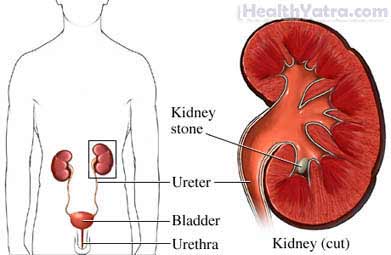تعريف
Extracorporeal shock wave lithotripsy is a nonsurgical treatment for kidney stones. It uses high-energy shock waves to break the stones into tiny pieces. The pieces can then be passed with urine.

أسباب هذا الإجراء
Lithotripsy is used to remove kidney stones that:
- Are too large to pass
- Cause constant pain
- Block the flow of urine
- Cause an ongoing infection
- Damage kidney tissue
- Cause bleeding
Most people who have lithotripsy for kidney stones are free of stones within three months of treatment. Patients with stones in the kidney and upper ureter have the most success with treatment. There may be fragments that are too large to pass after the procedure. They can be treated with lithotripsy again.
المضاعفات المحتملة
المشاكل من هذا الإجراء نادرة ، لكن جميع الإجراءات تنطوي على بعض المخاطر. سيراجع طبيبك المشاكل المحتملة ، مثل:
- دم في البول
- Bruising in the back or abdomen
- Pain as the stone fragments pass
- Failure of stone fragments to pass, requiring additional surgery
- Need for additional treatments
- رد فعل للتخدير
بعض العوامل التي قد تزيد من خطر المضاعفات تشمل:
- Bleeding disorders or taking medications that reduce blood clotting
- السمنة
- Skeletal deformities
ما يمكن توقعه
قبل الإجراء
قد يقوم طبيبك بما يلي:
- اختبار بدني
- اختبارات الدم والبول
- Imaging studies to help locate the stones
Talk to your doctor about your medications. You may be asked to stop taking some medications up to one week before the procedure, like:
- Aspirin or other anti-inflammatory drugs, such as ibuprofen and naproxen
- مخففات الدم ، مثل الوارفارين
- مضادات الصفائح الدموية ، مثل كلوبيدوجريل
التخدير
Heavy sedation or general anesthesia is usually used. Heavy sedation will keep you calm. With general anesthesia, you will be asleep. It will help you remain still and avoid discomfort.
وصف الإجراء
Shock waves can be passed to the stones in two ways:
- Water bath immersion—You will be placed in a tub of lukewarm water
- Soft cushion—You will be placed on soft cushions on top of a table
Your doctor will use x-rays or ultrasound to locate the stone. Your body will be positioned to target the stone. Shock waves will be passed through the stones until they are crushed. They will be crushed into pieces as small as grains of sand.
كم من الوقت سيستغرق ؟
45-60 دقيقة
كم هو مؤلم ؟
Anesthesia prevents pain during the procedure. There may be some pain and discomfort afterward from the passage of broken stones. There may also be some bruising on the area treated. Pain and discomfort after the procedure can be managed with medication.
الرعاية ما بعد الجراحة
You will be able to move almost immediately after the procedure. Be sure to follow your doctor’s instructions, which may include:
- Drink plenty of water in the weeks after the procedure to help the stone pieces pass.
- You will likely be able to resume daily activities within 1-2 days.
- Take oral pain medication as directed to help manage pain and discomfort.
استدعاء الطبيب
بعد وصوله الى المنزل ، اتصل بطبيبك إذا كان أي من الحالات التالية:
- Extreme urge or inability to urinate
- Excessive blood in your urine
- علامات الإصابة, بما في ذلك حمى وقشعريرة
- Nausea and/or vomiting that you cannot control with the medications you were given after the procedure
- Pain that you cannot control with the medications you have been given
- سعال أو ضيق في التنفس أو ألم في الصدر
إذا كنت تعتقد أن لديك حالة طارئة ، فاتصل بالمساعدة الطبية على الفور.
